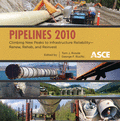Laboratory Investigations of Corrosion Mechanisms and Control for Ductile Iron Pipe in Simulated Polyethylene Encasement (AWWA C105)
Publication: Pipelines 2010: Climbing New Peaks to Infrastructure Reliability: Renew, Rehab, and Reinvest
Abstract
The objective of this study was to investigate the mechanisms of corrosion and corrosion control for ductile iron pipe (DIP) encased in polyethylene as specified in AWWA Standard C105. The current study is the second phase of a multiphase project funded by the Ductile Iron Pipe Research Association (DIPRA). In-situ measurements of corrosion rate were made for three types of probes placed in the narrow gap or annulus (∼2 mm) between a polyethylene encasing surface and the exterior surface of an asphalt coated DIP. The probes were comprised of carbon steel, DIP with an annealing oxide and DIP without an annealing oxide (Bare DIP). The electrolyte solution in the annulus space was slowly circulated through a reservoir with and without an external supply of oxygen. The electrolyte solution was made from soil water extracts so that actual soil chemistry and conditions could be accurately simulated. The pH and dissolved oxygen concentrations of the electrolyte solution were periodically measured in the reservoir. In-situ Electrical Resistance (ER) and Linear Polarization Resistance (LPR) measurements were made over the course of three months. Corrosion rate measurements are possible in the annulus space formed by polyethylene encasement of ductile iron pipe. The corrosion rate in the case of polyethylene encased carbon steel and ductile iron pipe is strongly influenced by the amount of oxygen available in the corrosive fluid. The corrosion rate decreases to near zero when the oxygen level of the electrolyte in the annular space drops to zero. Since the polyethylene encasement deprives the system of oxygen, corrosion is slowed or even stopped. This supports the effectiveness of corrosion control provided by polyethylene encasement. The long term corrosion mechanism occurring for ductile iron pipe is dominated by general uniform corrosion at the surface. This is especially true when oxygen is absent. Steady state corrosion rates for ductile iron pipe as manufactured with annealing oxide under conditions where soil pore water is saturated with air are low (less than 1 mil per year). The oxide surface of annealed ductile iron pipe protects the pipe from the electrolyte solution and buffers the pH thus mitigating corrosion. Ductile iron pipe without annealing oxide (bare DIP) experiences a high initial corrosion rate. The long term steady state corrosion rate under aerated conditions as determined by LPR (4 mils per year) and ER (1.2 to 0.6 mils per year) did not agree well. This may have been an artifact of the bead blasting of the sensor surface to remove the annealing oxide. The corrosion of carbon steel is dominated by localized corrosion or pitting. The long term steady state corrosion rate for carbon steel under aerated conditions may be as high as 4 mils per year.
Get full access to this article
View all available purchase options and get full access to this chapter.
Information & Authors
Information
Published In
Copyright
© 2010 American Society of Civil Engineers.
History
Published online: Apr 26, 2012
ASCE Technical Topics:
- Cast iron
- Corrosion
- Deterioration
- Engineering fundamentals
- Engineering materials (by type)
- Geomechanics
- Geotechnical engineering
- Infrastructure
- Iron (material)
- Laboratory tests
- Materials characterization
- Materials engineering
- Metals (material)
- Pipeline systems
- Pipes
- Plastics
- Polyethylene
- Soil mechanics
- Soil properties
- Soil water
- Synthetic materials
- Tests (by type)
Authors
Metrics & Citations
Metrics
Citations
Download citation
If you have the appropriate software installed, you can download article citation data to the citation manager of your choice. Simply select your manager software from the list below and click Download.
